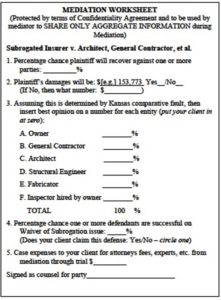By: Jerry Palmer, IAM Distinguished Fellow
Email: palmerjer@jpalmerlaw.com
Posted: July 10, 2015
Most mediators learn early in their practices that we never know as much about the case as the counsel do. The lawyer will always understand more about the risk aversion of the client because of fear of the courtroom, fear of the result, or the balance of opportunity and risk. The mediator will not have seen the witnesses, and can’t evaluate from a cold transcript the nonverbal disclosures that were observed by counsel. In construction cases where the parties have ongoing business relationships that may be impacted by the litigation, the complexity of those relationships cannot be easily communicated during the mediation. Each party undoubtedly has an opinion about the respective liabilities of each of the other parties, but getting them to share that prior to mediation, or even to make an assessment at mediation, is difficult and more likely to be inaccurate than if they gave it careful thought in advance by going through the exercise of filling out a Worksheet.
 To this end, I use a Mediation Worksheet by submitting it to counsel in advance of the mediation, asking them to disclose their opinions about the relative liabilities of the parties, the range of damages, and the out of pocket costs to their clients between the date of the mediation and trial. I specify that they should allocate fault in a way that adds up to 100%, but put zero in for their client. The zero designation avoids an overly-fair counsel putting in a reasonable number, while a more aggressive advocate puts in a negligible number. In addition, if there is a dispositive issue, to estimate the percentage chance that it will be decided favorably to that party.
To this end, I use a Mediation Worksheet by submitting it to counsel in advance of the mediation, asking them to disclose their opinions about the relative liabilities of the parties, the range of damages, and the out of pocket costs to their clients between the date of the mediation and trial. I specify that they should allocate fault in a way that adds up to 100%, but put zero in for their client. The zero designation avoids an overly-fair counsel putting in a reasonable number, while a more aggressive advocate puts in a negligible number. In addition, if there is a dispositive issue, to estimate the percentage chance that it will be decided favorably to that party.
After obtaining this information, I make a spreadsheet aggregating the information which gives a range of exposure for each party; I use it in caucus to encourage each party to make a greater contribution if they are low. My spreadsheet may well expose that the cost of litigation exceeds the amount in controversy. In addition, a dispositive issue may have a rating that can be used to encourage the plaintiff to reduce its demand. Having this information in advance can help me get initial contributions or critiques of proposed contributions as I try to assemble a pot of money from defendants to satisfy plaintiff’s demand.
A typical multi-party mediation may hope to get at least one demand and one collective offer on the table by the end of the first day. However, with a Mediation Worksheet – and especially in a case where expenses exceed the amount in controversy – I often am successful in getting the entire case resolved in one day.
